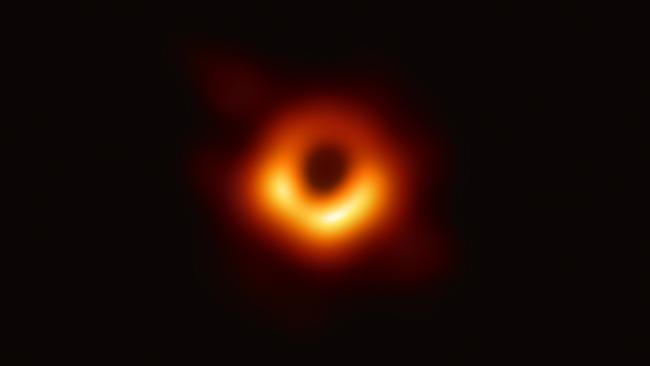Humanity gets first glimpse of one-way door out of universe
For the first time ever, scientists have released a photograph of a black hole, this one bigger than our solar system.

A century ago, a new kind of physics led to an outlandish prediction: Einstein’s general relativity suggested that there could be an object so massive that nothing could leave it — not even light.
For the first time ever late on Wednesday, scientists released a photograph of one of these objects, a black hole bigger than our solar system. Or, rather, they published a photograph of the void in space and time that it produces and the mass of material being pulled towards that void at almost the speed of light.
Sheperd Doeleman, of the Harvard-Smithsonian Centre for Astrophysics, said it was the culmination of years of work. “We are giving humanity its first view of a black hole — a one-way door out of our universe,” he said.
The project is known as the Event Horizon Telescope after the point surrounding every black hole where the pull of gravity becomes so strong that not even light can escape. For their first image, they looked at the supermassive black hole at the centre of galaxy M87, a behemoth 40 billion kilometres wide that weighs as much as 6.5 billion suns.
“This is a landmark in astronomy, an unprecedented scientific feat,” Professor Doeleman, the EHT project director, said as he released the image.
The picture, although fuzzy, matched closely the computer predictions. Luciano Rezzolla, from the Goethe University in Frankfurt, said that having a real observation was crucial. “We have transformed a mathematical concept, the event horizon — something I normally write on the blackboard when I lecture — into a physical object,” he said. “It is something we can test and measure. You may think that is a minor thing. Actually, it is fundamental.”
The work is the result of a complex international collaboration, which has achieved something many thought impossible. There is a theoretical limit to the size of objects that can be seen through telescopes.
Galaxy M87 is far enough away that seeing its central black hole, even one that happens to be among the most massive objects in the known universe, is like spotting a mustard seed in New York while in London. A telescope the size of Earth would be required to see it. The astronomers effectively created that by combining images from eight radio telescopes.
Astronomers around the world synchronised their readings using atomic clocks on the same nights, when there was perfect weather at each site.
These were interpolated, using complex computer algorithms, to produce a single image of the black hole.
Katie Bouman, from the Massachusetts Institute of Technology, said the process was like a police sketch artist using “limited descriptions to piece together a picture”.
Ziri Younsi, from University College London, who was involved in the project, said that knowledge gained from black holes could help to fill in gaps in our concept of the universe.
The Times


